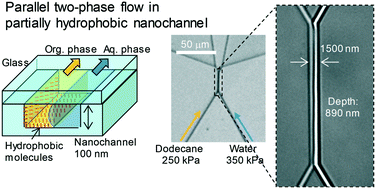Parallel multiphase nanofluidics utilizing nanochannels with partial hydrophobic surface modification and application to femtoliter solvent extraction†
Abstract
In the field of microfluidics, utilizing parallel multiphase flows with immiscible liquid/liquid or gas/liquid interfaces along a microchannel has achieved the integration of various chemical processes for analyses and syntheses. Recently, our group has developed nanofluidics that exploits 100 nm nanochannels to realize ultra-small (aL to fL scale) and highly efficient chemical operations. Novel applications such as single-molecule analyses and single-cell omics are anticipated. However, the formation of parallel multiphase flows in a nanochannel remains challenging. To this end, here we developed a novel method for nanoscale partial hydrophobic surface modification of a nanochannel utilizing a focused ion beam. Hydrophobic and hydrophilic areas could be patterned beside one another even in a 60 nm glass nanochannel. Because this patterning maintained the liquid/liquid interface in the nanochannel based on the difference in wettability, stable aqueous/organic parallel two-phase flow in a 40 fL nanochannel was realized for the first time. Utilizing this flow, nanoscale unit operations involving phase confluence, extraction and phase separation were integrated to demonstrate solvent extraction of a lipid according to the Bligh–Dyer method, which is a broadly used pretreatment process in lipidomics. We accomplished the separation of a lipid and an amino acid in a sample volume of 4 fL (250 times smaller than the pL volume of a single cell) with a processing time of 1 ms (10 000 times faster than that in a microchannel). This study therefore provides a technological breakthrough that advances the field of nanofluidics to allow multiphase chemical processing at fL volumes.



 Please wait while we load your content...
Please wait while we load your content...
